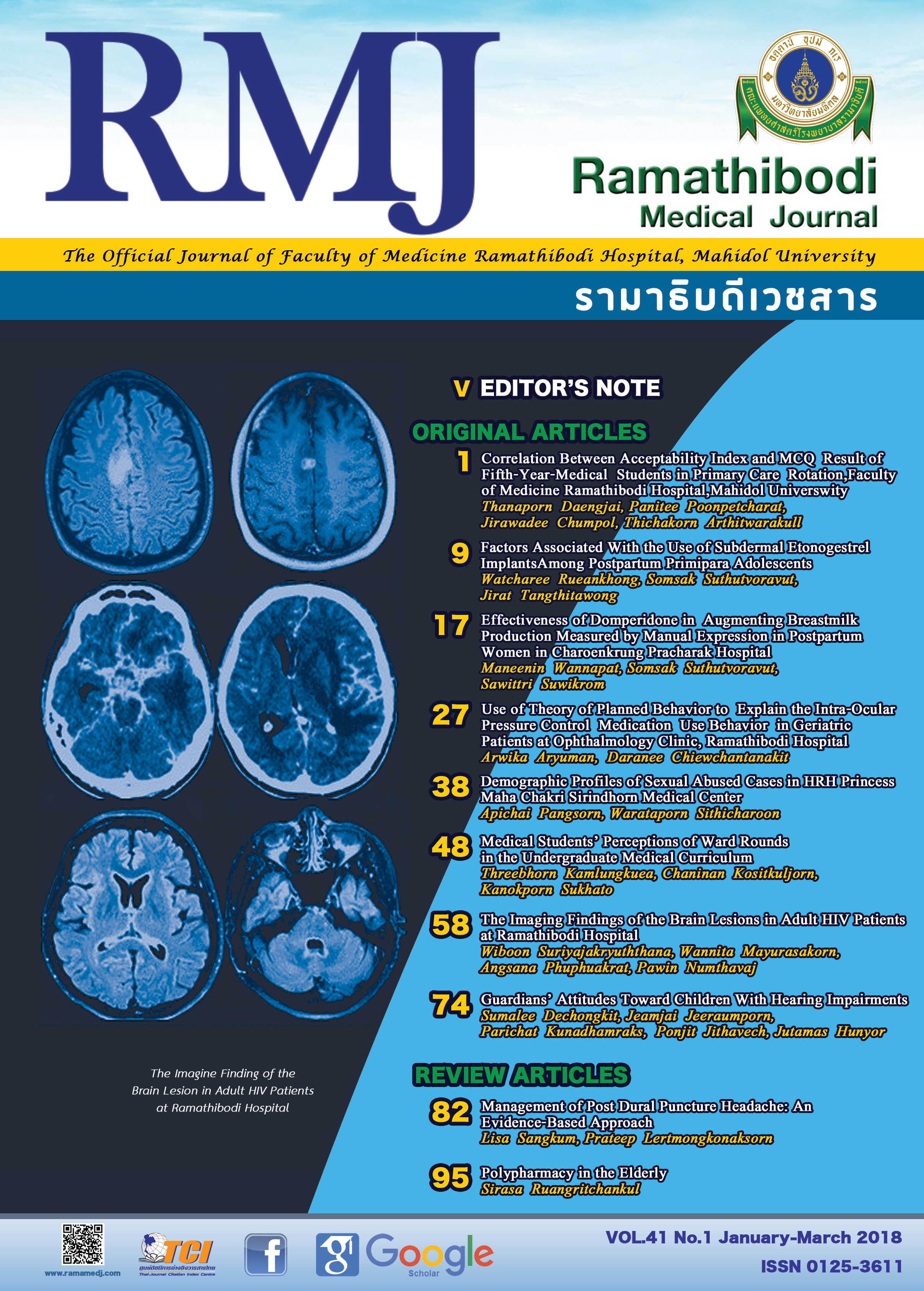Factors Associated With the Use of Subdermal Etonogestrel Implants Among Postpartum Primipara Adolescents
DOI:
https://doi.org/10.14456/rmj.2018.2Keywords:
Contraception, Long acting reversible contraceptions, Implant, Postpartum, Primipara adolescentsAbstract
Background: In Thailand, there has been a high incidence of adolescent pregnancy which leads to major public health and socioeconomic problems such as unplanned pregnancy, induced abortion and negative impacts on the health of the mothers and newborns. Contraception among adolescents is so important that it can prevent those problem, especially subdermal etonogestrel implant which are recommended to be effective and suitable for adolescents.
Objective: To study the rate of use and factors associated with the use of subdermal etonogestrel implants among postpartum primipara adolescents in Saraburi province.
Methods: This study is an observational descriptive research. The population were 106 primipara adolescents at 4 - 6 weeks postpartum period at three hospitals in Saraburi province (ie, Saraburi Hospital, Pra-putabat Hospital, and Banmoh Hospital). Data was collected by interviewing postpartum primipara adolescents from March 21, 2016, to June 30, 2016. Data was analyzed by descriptive statistics which included frequency, percentage, mean and stranded deviation. Test of hypothesis was done by chi-square test, Fisher’s exact test and multiple logistic regression analysis with the significant level at P < 0.05.
Results: Among 106 postpartum primipara adolescents, 93.4% used contraceptives (31.1% used subdermal etonogestrel implant; 62.3% used other reversible contraceptions [eg, depot medroxyprogesterone acetate injection, oral contraceptions and condoms]), and 6.6% used no contraception. By univariate analysis, factors significantly associated with the use of implant among primipara adolescents included age of primipara adolescents, age of husband, expense, convenience of use, side effects, application pain, duration of contraception and medical personnel’s recommendation. When multiple logistic regression analysis was applied, only four factors were significantly associated with the use of implant. The most significant factor was medical personnel’s recommendation. The other significant factors were expense, age of husband and duration of contraception.
Conclusion: Most of primipara adolescents at 4 - 6 weeks postpartum period in Saraburi province used contraceptives. Subdermal etonogestrel implants was the second most common contraceptive used. The most important factor for the use of implant was medical personnel’s advice which emphasized on the use of implants in order to prevent unplanned pregnancy among adolescents.
References
United Nation Population Fund Thailand Country Office and the Office of the National Economics and Social Development Board. Chapter 1 Access to basic rights–the foundation for preventing adolescent pregnancy. Motherhood in childhood facing the challenge of adolescent pregnancy 2013. Bangkok; Success Publication; 2014:1-8.
Rome E. Use of long-acting reversible contraceptives to reduce the rate of teen pregnancy. Cleve Clin J Med. 2015;82(11 Suppl 1):S8-S12. doi:10.3949/ccjm.82.s1.02.
Guar AS, Guar SS. Chapter 9 Logistic regression. Statistical methods for practice and research; A guide to data analysis using SPSS. New Delhi: Response Books/Sage Publications; 2007:121-130.
McNicholas C, Peipert JF. Long-acting reversible contraception for adolescent. Curr Opin Obstet Gynecol. 2012;24(5):293-298. doi:10.1097/GCO.0b013e32835686d5.
Finer LB, Zoina MR. Unintended pregnancy in the United State: incidence and disparities, 2006. Contraception. 2011:84(5):478-485. doi:10.1016/j.contraception.2011.07.013.
Chacko MR, Wiemann CM, Buzi RS, Kozinetz CA, Peskin M, Smith PB. Choice of postpartum contraception: factors predisposing pregnant adolescents to choose less effective methods over long-acting reversible contraception. J Adolesc Health. 2016;58(6):628-635. doi:10.1016/j.jadohealth.2015.12.002.
Eisenberg D, McNicholas C, Peipert JF. Cost as a barrier to long-acting reversible contraceptive (LARC) use in adolescents. J Adolesc Health. 2013;52(4 Suppl):S59-S63. doi:10.1016/j.jadohealth.2013.01.012.
Kumar N, Brown JD. Access barriers to long acting reversible contraceptive for adolescents. J Adolesc Health. 2016;59(3):248-253. doi:10.1016/j.jadohealth.2016.03.039.
Pritt NM, Norris AH, Berlan ED. Barriers and facilitators to adolescents’ use of long acting reversible contraceptive. J Pediatr Adolesc Gynecol. 2017;30(1):18-22. doi:10.1016/j.jpag.2016.07.002.
Downloads
Published
How to Cite
Issue
Section
License
Copyright (c) 2018 By the authors. Licensee RMJ, Faculty of Medicine Ramathibodi Hospital, Mahidol University, Bangkok, Thailand

This work is licensed under a Creative Commons Attribution-NonCommercial-NoDerivatives 4.0 International License.

















